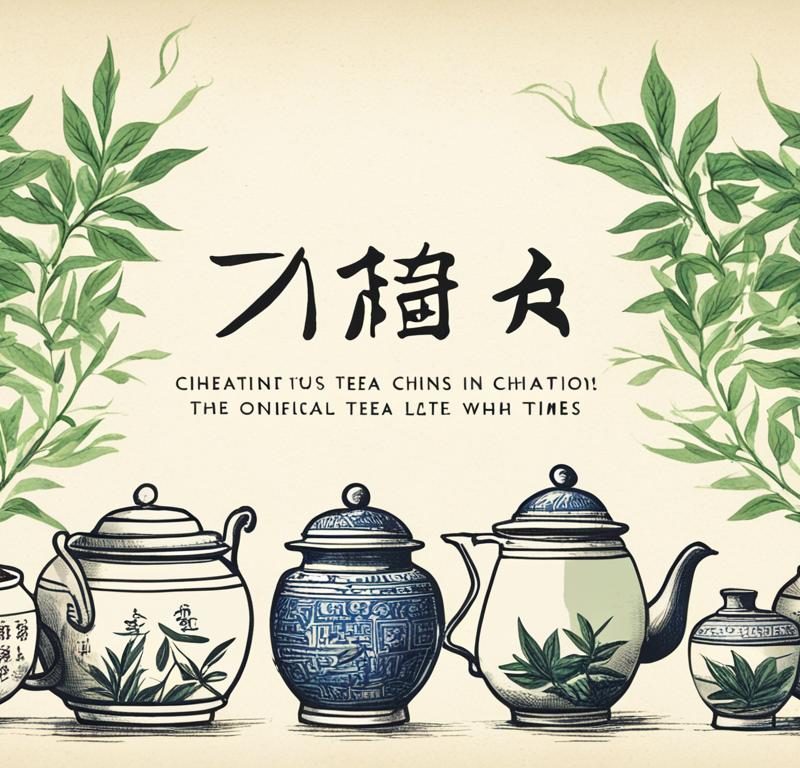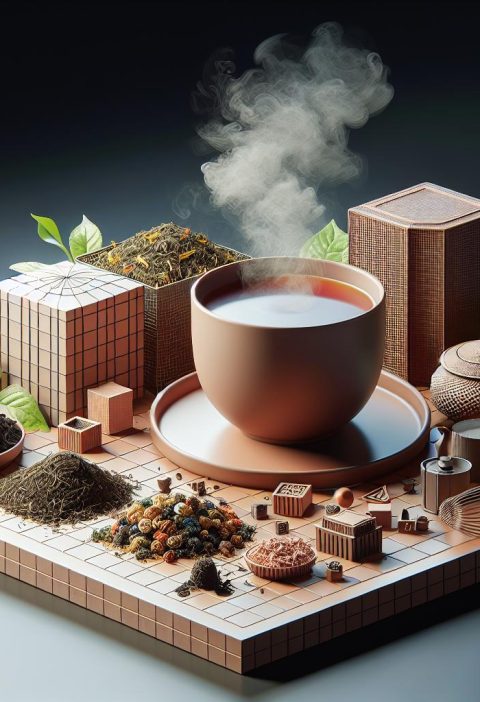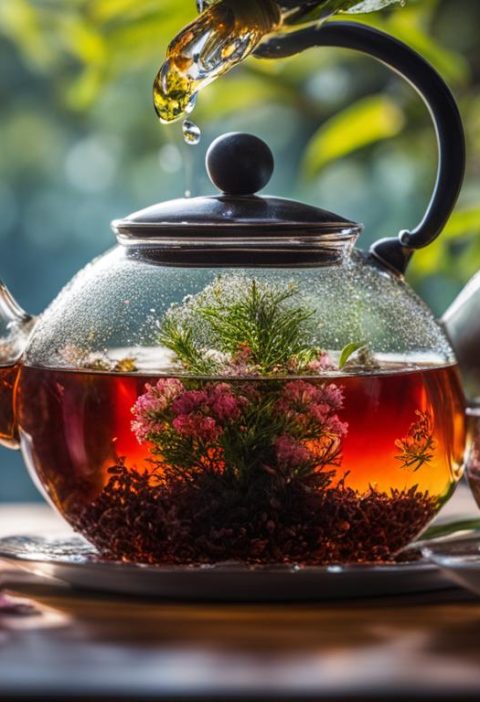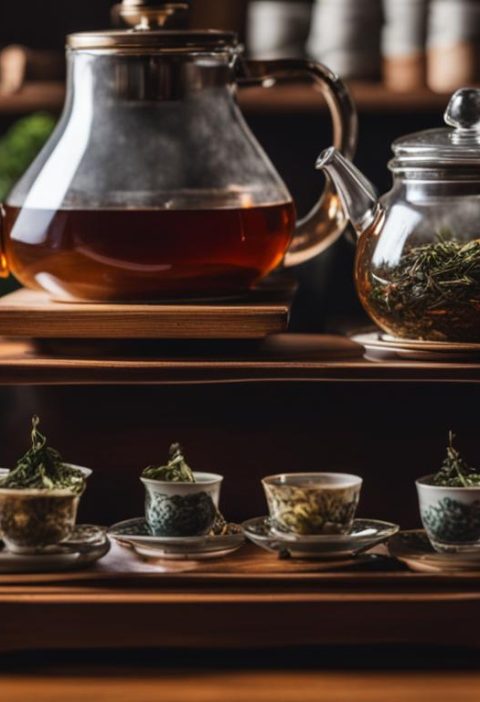Tea leaf reading, also known as tasseography, is an ancient divination practice that involves interpreting symbols and messages found in the shapes and configurations of tea leaves. This mystical art has a rich history and is a powerful way to exercise intuition. By directing energy into the tea leaves, practitioners can gain insights into the past, present, and future. The symbols in tea leaves are embedded within their shape, density, color, and placement. A comprehensive guide to tea leaf reading was written by “A Highland Seer” in 1881 and is still considered a valuable resource by many tea readers.
The History and Significance of Tea Leaf Reading
Tea has a rich and dynamic history, often associated with colonialism, violence, and revolution. However, it is also enjoyed in various cultures around the world. Tea leaf reading, or tasseography, has its roots in Middle Eastern, Chinese, and European folklore. The practice has been used for centuries to gain insights into the future and explore hidden messages. The symbols and patterns found in tea leaves carry significant meaning and can provide guidance and advice to those who practice tasseography.
Key Takeaways:
- Tasseography is an ancient divination practice that involves interpreting symbols and messages found in tea leaves.
- Tea leaf reading has a rich history and is associated with various cultures around the world.
- Tea leaves carry significant meaning and can provide guidance and advice.
Getting Started with Tasseography
Tasseography is an accessible form of divination that anyone can learn. It is less structured than reading tarot cards or using crystals, making it a great option for beginners. To get started with tea leaf reading, one simply needs loose-leaf tea, intention, and a willingness to tap into their intuition. By focusing their energy and asking a question, practitioners can interpret the symbols and patterns that appear in the wet tea leaves. Tasseography offers a unique and creative way to cultivate a personalized divination practice.
Key Takeaways:
- Tasseography is an accessible form of divination that is less structured than other practices.
- You can get started with tea leaf reading using loose-leaf tea and your intuition.
- Tasseography offers a unique way to develop a personalized divination practice.
The History and Significance of Tea Leaf Reading
Tea has a rich and dynamic history, intertwined with stories of colonialism, violence, and revolution. However, it is also deeply rooted in the cultural traditions of various societies around the world. One intriguing aspect of tea culture is tea leaf reading, also known as tasseography. Its origins can be traced back to Middle Eastern, Chinese, and European folklore.
Tea leaf reading has been practiced for centuries as a means to gain insights into the future and uncover hidden messages. The symbols and patterns that emerge from the wet tea leaves hold great significance and can provide valuable guidance and advice to those who engage in tasseography.
Colonialism and the global tea trade played a significant role in the spread of tea leaf reading. As tea was introduced to different parts of the world, cultural traditions surrounding the beverage flourished and, with them, the practice of reading tea leaves. The blending of cultural influences and beliefs contributed to the diversity of tea leaf reading techniques and interpretations.
Tasseography reflects the rich tapestry of human experience and cultural diversity. It serves as a fascinating window into the ways in which people have sought to understand the world around them and uncover hidden truths. Through the study of tea leaf symbols, one can delve into the collective wisdom and cultural traditions that have shaped this unique divination practice.
Comparing Tea Leaf Reading Traditions
| Region | Tea Leaf Reading Tradition | Key Symbols |
|---|---|---|
| Middle East | Tasseography | Hamsa Hand, Crescent Moon, Camel |
| China | Chalography | Dragons, Pagodas, Plum Blossoms |
| Europe | Tea Cup Reading | Hearts, Keys, Birds |
This diverse array of tea leaf reading traditions showcases the unique symbols and cultural significance attributed to tea leaves in different regions. Each tradition offers its own interpretation and methodology, adding to the rich tapestry of tea leaf reading practices.
Getting Started with Tasseography
Welcome to the beginner’s guide to tea leaf reading! If you’re interested in exploring the mystical art of tasseography and developing your intuition, you’re in the right place. Tea leaf reading is a unique divination practice that offers a creative way to tap into your subconscious and gain insights into your life.
Tasseography is a less structured form of divination compared to tarot cards or crystals, making it an excellent starting point for beginners. With just a few simple tools and a willingness to trust your intuition, you can embark on this fascinating journey of self-discovery and magical exploration.
So, how do you start your tea leaf reading adventure? It’s as simple as brewing a cup of loose-leaf tea and setting your intention.
Here’s a step-by-step guide to help you begin your tea leaf reading practice:
Gather Your Tools
To get started, you’ll need the following:
- A cup or teapot
- Loose-leaf tea (preferably a black or herbal blend)
- A tea sieve or strainer
Set Your Intention
Before you start brewing your tea, take a moment to set your intention. Think about the question or area of life you’d like guidance on. This could be anything from relationships to career choices or personal growth.
By focusing your energy on your intention, you create a sacred space for divination and invite the symbols and messages to reveal themselves.
Brew Your Tea
Boil water and pour it over the loose-leaf tea in your cup or teapot. Allow it to steep for a few minutes, allowing the flavors to infuse and the magic to unfold.
Remember, this is not just a regular cup of tea; it’s a portal to the realm of intuition and guidance.
Once the tea has steeped, pour it through a tea sieve or strainer to separate the liquid from the leaves. Set the liquid aside for later enjoyment or discard it if you prefer.
Look for Symbols and Patterns
Now comes the exciting part—interpreting the symbols and patterns that appear in the wet tea leaves. Take a moment to observe the leaves in the bottom of your cup or teapot.
Note: The image above serves as a visual representation of the tea leaf reading process and may not reflect the actual symbols you might encounter.
Pay attention to the shapes, lines, and configurations within the leaves. Trust your intuition and let your imagination guide you as you decipher the hidden meanings and messages they hold.
Keep a Journal
As you begin your tea leaf reading journey, it’s helpful to keep a journal of your interpretations and experiences. This allows you to track your progress, note any recurring symbolism, and deepen your understanding of the tea leaf language.
Remember, tea leaf reading is a personal and intuitive practice. The symbols and meanings may vary from person to person, making your interpretations unique to your own experiences and intuition. Embrace this subjective nature of tea leaf reading and let it enhance your divination practice.
Now that you’re familiar with the basics of tea leaf reading, it’s time to make a cup of tea, set your intention, and embark on your own personal journey of self-discovery through the mystical art of tasseography.
| Key Steps | Tips |
|---|---|
| Gather Your Tools | – Choose a cup or teapot that resonates with you – Experiment with different blends of loose-leaf tea to find your favorite |
| Set Your Intention | – Focus on one specific question or area of life – Clear your mind and be open to receiving guidance |
| Brew Your Tea | – Experiment with different brewing techniques and temperatures – Take your time and savor the moment |
| Look for Symbols and Patterns | – Don’t overthink the interpretation; let your intuition guide you – Pay attention to recurring symbols or themes |
| Keep a Journal | – Write down your interpretations and any intuitive insights – Reflect on your experiences and personal growth |
Symbols in Tea Leaf Reading
Tea leaf reading, also known as tasseography, involves interpreting a variety of symbols that appear in the tea leaves. These symbols can represent different qualities and characteristics, providing insights into various aspects of one’s life. Here are some common symbols encountered in tea leaf reading:
Animal Symbols
- Cats: Mystery, intuition
- Birds: Freedom, important news
- Horses: Strength, endurance
- Snakes: Transformation, healing
- Fish: Abundance, good fortune
Object Symbols
- Keys: Opportunities, knowledge
- Rings: Relationships, commitments
- Books: Wisdom, learning
- Hourglasses: Time, patience
- Candles: Guidance, enlightenment
Shape Symbols
- Circles: Wholeness, completion
- Squares: Stability, security
- Triangles: Change, growth
- Lines: Direction, movement
- Stars: Aspirations, inspiration
Number and Letter Symbols
Numbers and letters that appear in the tea leaves can also hold significance and provide further insights into the reading. For example:
| Number | Symbolism |
|---|---|
| 1 | New beginnings, independence |
| 3 | Creativity, expansion |
| 7 | Intuition, spiritual growth |
| 9 | Completion, fulfillment |
Please note that the interpretation of numbers and letters may vary based on personal experiences and cultural beliefs.
Astrological Symbols
Astrological symbols can also appear in tea leaf readings, offering further insights into the influences of the planets and celestial bodies. These symbols may include:
- Sun: Vitality, success
- Moon: Intuition, emotions
- Mercury: Communication, intelligence
- Venus: Love, relationships
- Mars: Energy, assertiveness
Interpreting these symbols in the context of the surrounding tea leaf patterns allows tea leaf readers to provide meaningful guidance and advice to those seeking insight into their lives.
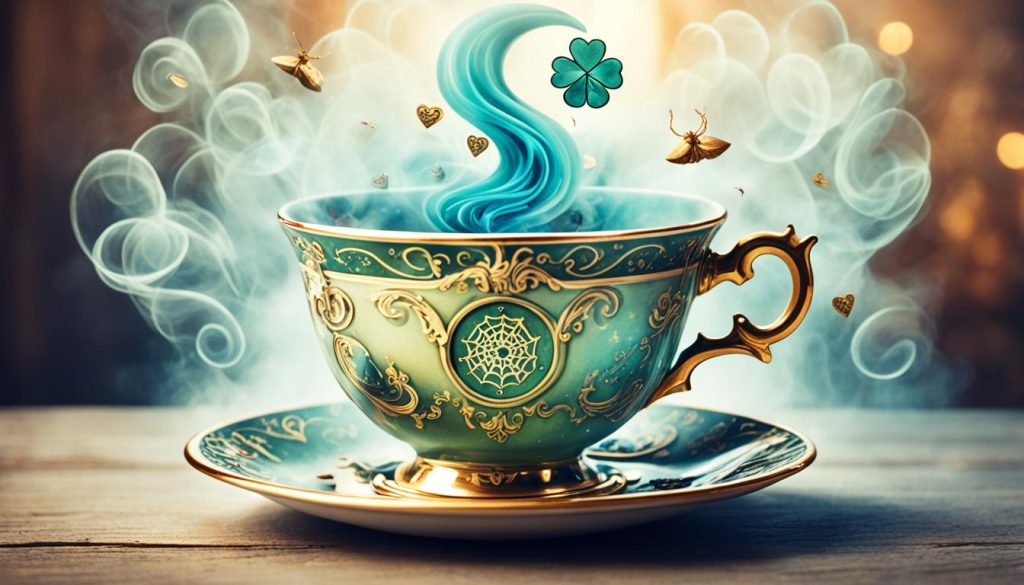
Ritual Steps for Tea Leaf Reading
Tea leaf reading, also known as tasseography or tasseomancy, is a fascinating practice that involves interpreting symbols and patterns found in the tea leaves. This ancient divination art provides us with insights and guidance into our lives. It is a ritualistic process that requires mindfulness, intention, and an open mind.
Step 1: Brewing Tea
To begin your tea leaf reading journey, choose your favorite loose-leaf tea. This can be a blend that resonates with you or one that holds special meaning. As you brew the tea, infuse it with your intentions and positive energy. Visualize your question or the area of your life you seek guidance for.
Step 2: Pouring Tea Mindfully
Once the tea is ready, gently pour it into a cup, allowing the leaves to settle at the bottom. Observe the way the leaves intertwine and form unique patterns. This mindful pouring process helps to create a connection between you and the tea, establishing a sacred space for the reading.
Step 3: Sipping with Intention
Hold the cup in your hands and take slow, deliberate sips, savoring the flavors and textures of the tea. While doing so, keep your thoughts and energies focused on your specific question or area of life. Allow the tea to awaken your intuition and create a receptive state of mind.
Step 4: Decoding Symbols
As you sip, pay attention to the symbols and patterns that emerge from the tea leaves. Look closely for any shapes, lines, or images that catch your eye. Each symbol holds a unique significance and can provide insights into your question or situation. Trust your intuition and allow the symbols to speak to you.
Step 5: Embracing Wisdom
Embrace the wisdom revealed by the tea leaves and interpret the symbols in a way that resonates with you. Remember that tea leaf reading is a deeply personal experience, and the meanings may vary from person to person. Embrace the guidance and insights offered by the tea leaves, and trust in your own intuition.
Cultural and Personal Interpretations in Tasseography
The art of tea leaf reading, or tasseography, involves interpreting symbols found in the patterns created by the tea leaves. These symbols hold significant meaning and can provide guidance and insights into various aspects of one’s life. However, it’s important to recognize that the interpretation of these symbols can vary based on cultural beliefs and personal associations.
Different cultures and belief systems attribute diverse meanings to symbols, numbers, and letters. For example, in some cultures, seeing a bird in the tea leaves may represent freedom and new beginnings, while in others, it may symbolize an upcoming journey or important news. Similarly, a number that holds personal significance for one person may have a different meaning for someone else.
Furthermore, personal associations play a significant role in interpreting the symbols. Each individual brings their own experiences, emotions, and intuitive insights to the practice of tasseography. A symbol that resonates deeply with one person may have a completely different interpretation for another. These personal associations can add layers of meaning to the reading and make it a deeply subjective and personal experience.
It’s crucial to approach tasseography with an open mind and a sense of curiosity. Recognize that the interpretation of symbols is subjective and can vary between individuals. Embrace your own cultural background and personal experiences while exploring the symbols in the tea leaves.
The Subjective Nature of Tasseography
Tasseography is inherently subjective due to its reliance on intuition and personal connections. Each practitioner brings their unique perspective, energy, and intuitive abilities to the reading. This subjectivity allows for a personalized and meaningful experience with the symbols.
As you delve into the world of tea leaf reading, trust your instincts and embrace your own intuitive insights. Pay attention to the symbols that resonate with you and explore their meanings in relation to your own life experiences. This self-reflection and introspection will enhance your understanding of the symbols and their significance.
When engaging in tasseography, remember that there is no right or wrong interpretation. It’s about the personal meaning that the symbols hold for you and the guidance they provide in your journey. Allow yourself to tap into your intuition and let the symbols speak to you in a way that feels authentic and true.
Cultural Interpretations in Tea Leaf Reading
The cultural influences on tea leaf reading cannot be ignored. Symbols in tasseography often have specific meanings within particular cultures or belief systems. For example, certain astrological symbols may hold significance in Western interpretations, while Chinese interpretations may involve traditional symbols specific to their culture.
It can be fascinating to explore the historical and cultural interpretations of the symbols found in tea leaves. Learning about different cultural beliefs and the symbolism associated with various objects, animals, shapes, and numbers can deepen your understanding of tasseography. It can also expand your perspective and allow you to appreciate the diversity of symbolism across cultures.
Incorporating different cultural interpretations into your own tea leaf reading practice can add depth and richness to your readings. It opens up new avenues for exploration and provides a broader context for the symbols that appear in the tea leaves.
The Magic of Personal Associations
Personal associations with symbols play a significant role in tea leaf reading. Symbols may evoke specific emotions, memories, or connections to personal experiences. These associations bring a unique and deeply personal element to the interpretation of tea leaf patterns.
For example, if seeing a rose in the tea leaves reminds you of a cherished memory with a loved one, it may symbolize love, affection, and beautiful experiences for you personally. However, for someone else, the rose may represent something entirely different based on their own associations and experiences.
Personal associations allow for a more intimate and meaningful connection with the symbols. They make the practice of tasseography deeply personal and can bring forth insights and messages specific to your individual journey.
As you continue to explore the world of tea leaf reading, embrace the cultural interpretations and personal associations that add depth and uniqueness to your practice. Enjoy the journey of discovering the symbolism in the tea leaves and the wisdom they reveal about your own life.
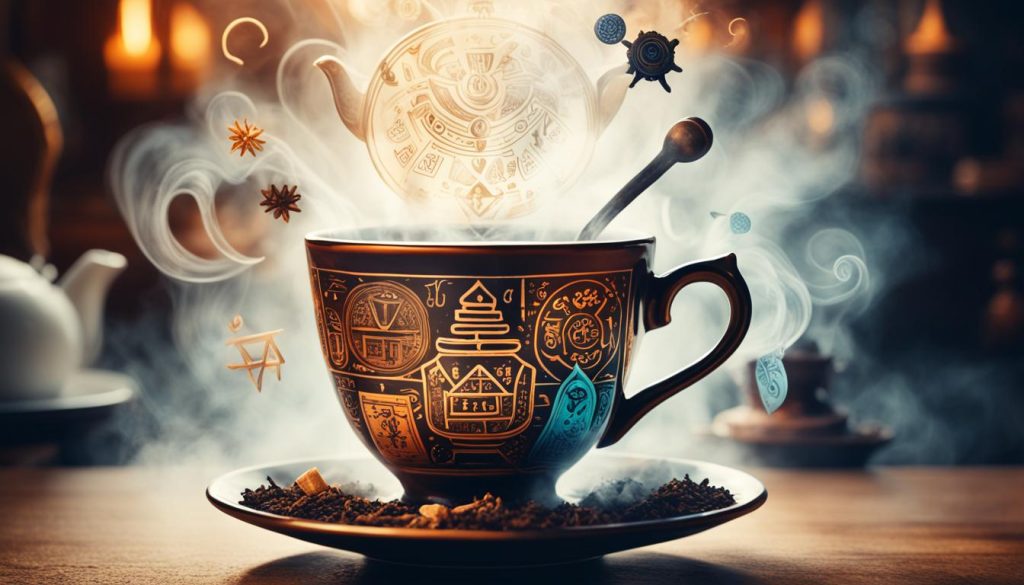
| Cultural Interpretations | Personal Associations |
|---|---|
| In some cultures, an owl in the tea leaves may symbolize wisdom and intuition. | For someone with a personal connection to owls, it may symbolize spiritual guidance and insight. |
| A heart shape in the tea leaves can represent love and affection. | For a person who recently experienced a heartwarming event, it may symbolize happiness and emotional fulfillment. |
| The number seven often signifies luck in many cultures. | For someone who believes in lucky numbers, the appearance of the number seven may bring a sense of hope and positivity. |
| A snake in the tea leaves can have different meanings across cultures, such as transformation or deceit. | For someone with a personal fear or fascination with snakes, it may symbolize the need for self-reflection and embracing change. |
The Magic of Tea Leaf Reading
Tea leaf reading holds a certain magic in its ability to tap into intuition and reveal hidden truths. When we focus our magickal intention on the tea, the leaves become conduits for mirroring experiences and providing guidance, offering a glimpse into the unseen forces that shape our lives.
Through the art of tea leaf reading, we have the opportunity to unravel the mysteries that lie beneath the surface, unlocking the wisdom that resides within the delicate leaves. These mystical messages are embedded within their subtle shape, density, color, and placement, creating a tapestry of symbols waiting to be deciphered. Tapping into our intuition and embracing the unique language of the tea leaves, we can uncover the hidden truths that can provide guidance and clarity in our journey.
Just like magicians who use their intuition and mastery to astound and inspire, we too can tap into the magic of tea leaf reading to awaken our senses and gain deeper insights. By trusting our instincts and allowing the symbols to speak to us, we can access a deeper realm of consciousness, where the answers to our burning questions lie. The tea leaves become our partners in this mystical dance, offering glimpses into the future, revealing hidden blockages, and whispering words of wisdom.
The magic of tea leaf reading lies not only in predicting the future but also in transforming the present moment. As we engage with the tea leaves, we cultivate a connection to our inner selves, unlocking our innate wisdom and allowing it to guide us on our path. The symbols that emerge from the tea leaves have the power to awaken our inner truth, inspiring us to take action, make important decisions, or gain clarity on dilemmas that have perplexed us.
Embedded within the delicate leaves are the keys to unlocking the mysteries of our lives. By embracing the magic of tea leaf reading, we can embark on a mystical journey of self-discovery and illumination. The symbols that emerge offer whispers of insight and guidance, inviting us to explore the depths of our own being and tap into the profound truths that shape our existence.
As we sip from the cup of wisdom, the hidden truths and messages encoded within the tea leaves reveal themselves to those who are open and receptive. This ancient practice allows us to access a realm of knowledge that transcends the limitations of our everyday lives, offering a portal into a world of magic, mystery, and infinite possibilities.
The Magic of Tea Leaf Reading: Providing Guidance and Clarity
Tea leaf reading is a powerful tool for providing guidance and clarity in our lives. Each symbol and pattern that emerges from the tea leaves carries a unique message and insight, tailored to our individual experience and situation. As we delve into the magical language of tea leaves, we unlock a source of ancient wisdom that can help us navigate the challenges and opportunities that lie ahead.
Through tea leaf reading, we gain access to a deeper understanding of ourselves and our journey. The symbols and patterns become the language through which our intuition speaks, guiding us towards the answers and solutions we seek. By embracing the magic of tea leaf reading, we tap into a wellspring of ancient knowledge that can illuminate our path and empower us to make informed decisions.
So, let us embark on this enchanting journey into the world of tea leaf reading, where hidden truths are revealed, and guidance and clarity await.
Enhancing Your Tasseography Practice
Enhancing your tasseography practice can bring a new level of depth and magic to your tea leaf reading sessions. Here are some ideas to spice up your practice and invite new experiences and insights:
- Incorporate Tea Leaf Reading into a Witchy Tea Party: Hosting a themed tea party centered around tea leaf reading can create a unique and magical atmosphere. Set the mood with mystical decorations, play calming music, and encourage your guests to participate in the divination process. It’s a wonderful opportunity to connect with others who share your interest in tasseography and exchange experiences and interpretations.
- Share Your Divination Experiences: Engaging in conversations with fellow practitioners can deepen your understanding of tea leaf reading and offer different perspectives on symbols and meanings. Attend workshops, join online communities, or organize gatherings where you can share your divination experiences and learn from others. Collaborative learning and discussions can broaden your knowledge and enhance your intuitive abilities.
- Document Your Readings: Keeping a journal of your tea leaf reading sessions allows you to track themes, recurring symbols, and your interpretations over time. This can help you identify patterns and develop a personal symbolism system. You can also use your journal to reflect on your intuitive insights and track the accuracy of your readings.
- Experiment with Different Tea Varieties: Each tea variety possesses its own energy and flavor profile. By incorporating different teas into your tasseography practice, you can explore how different blends and flavors may influence the symbols and messages that emerge from the leaves. Keep note of any variations you observe and how they align with your readings.
- Connect with Nature: Consider taking your tea leaf reading practice outdoors and connecting with the natural elements. Find a peaceful spot in nature, brew your tea, and immerse yourself in the sounds, scents, and energies of the environment. Nature can enhance your intuitive abilities and bring a deeper sense of connection to the symbols and messages in the tea leaves.
By incorporating these suggestions into your spiritual practice, you can continue to enhance your tea leaf reading skills, deepen your connection with the symbols and messages found in the tea leaves, and open yourself up to new insights and perspectives.
Embracing the Subjectivity of Tasseography
In the mystical art of tea leaf reading, it’s important to recognize and embrace the subjective nature of this practice. Each tea leaf reader brings their own unique perspective and personal connection to the symbols and patterns that emerge in the tea leaves. The interpretation of these symbols goes beyond fixed meanings and relies heavily on intuition and individual experiences.
When engaging in tasseography, trust your instincts and allow your intuition to guide you. As you develop a deeper understanding of the symbols, you’ll begin to form your own interpretations that resonate with you on a personal level. Embracing the subjectivity of tea leaf reading not only enriches your practice but also allows for a more meaningful exploration of the messages hidden within the tea leaves.
Interpretation through Intuition
Intuition plays a pivotal role in tea leaf reading. It is the intuitive connection to the symbols that allows practitioners to unlock the deeper meanings behind them. While there are traditional interpretations associated with certain symbols, it’s essential to trust your intuitive insights and consider the symbolism in relation to your own life experiences.
Interpretation through intuition invites you to tap into your inner wisdom and allows the symbols to speak to you in a personal way. By embracing your intuition, you can delve into a more profound exploration of the symbols and uncover hidden layers of meaning that are uniquely relevant to you.
Personal Connection with Symbols
In tea leaf reading, the symbols that appear in the leaves establish a personal connection with the reader. This connection is formed through a combination of the reader’s experiences, beliefs, and individual associations with the symbols.
Your personal connection with the symbols may differ from others, and that’s perfectly valid. A symbol that holds deep significance for you might elicit a different response or interpretation for someone else. This personal connection allows you to gain insights and messages that are specific to your journey and circumstances.
Building a personal connection with the symbols takes time and practice. It involves exploring your feelings, thoughts, and reactions when encountering different symbols during tea leaf readings. Over time, you’ll develop a unique understanding of the symbols and their resonances with your own life, enhancing the depth and richness of your tasseography practice.
The Subjective Nature of Tasseography
Tasseography, by nature, carries a subjective essence. The interpretation of symbols in the tea leaves is not fixed or universally standardized. Instead, it is influenced by the reader’s perception, intuition, and personal associations.
While certain symbols may hold commonly accepted meanings within tradition, the meaning they hold for you may differ. The subjective nature of tasseography allows for a more fluid interpretation that aligns with your individual understanding and experiences.
By embracing the subjective nature of tea leaf reading, you open yourself up to a world of exploration and personal growth. It encourages you to trust your intuition, form a deep connection with the symbols, and unlock the hidden wisdom that resides within.
| Key Points |
|---|
| Interpretation in tea leaf reading relies heavily on intuition and personal experiences. |
| A personal connection with symbols enhances the depth and relevance of tea leaf readings. |
| Tasseography is inherently subjective, allowing for individual interpretations and meanings. |
Ethical Considerations in Tasseography
As with any divination practice, it is essential to approach tasseography with respect and ethical considerations. Respecting privacy and boundaries is crucial, especially when reading tea leaves for others. It’s important to obtain consent and create a safe and comfortable space for the reading. Practitioners should also be mindful of their intentions and ensure that their practice is conducted with integrity and respect for the individuals involved.
Creating an Ethical Practice
When engaging in tea leaf reading, it’s important to establish ethical guidelines that prioritize the well-being and autonomy of those seeking readings. Here are a few key considerations:
- Respect Privacy: Tea leaf reading can reveal personal and sensitive information. Always honor the privacy of those seeking readings and maintain strict confidentiality.
- Secure Consent: Before conducting a tea leaf reading for someone, obtain their explicit consent. Clearly explain the purpose and nature of the reading, ensuring they fully understand what to expect.
- Create a Safe Environment: Establish a safe and comfortable space for the reading, free from distractions or interruptions. Consider the emotional well-being of the individual and create an atmosphere of trust and openness.
- Recognize Boundaries: Understand and respect personal boundaries. Avoid probing or prying into areas of someone’s life they are not comfortable discussing. Focus on providing guidance and insight within the boundaries set by the individual.
The Importance of Integrity
Integrity is paramount when practicing tasseography. Practitioners should approach tea leaf reading with sincerity and a genuine desire to help others. Here are some principles to uphold:
- Non-judgmental Attitude: Maintain a non-judgmental stance throughout the reading and refrain from passing moral assessments or making unwarranted assumptions about the individual.
- Avoid Exploitation: Never exploit vulnerable individuals seeking guidance. Guide them towards making their own decisions and empower them to take control of their lives.
- Transparency: Be transparent about your abilities and limitations as a tea leaf reader. Avoid making grandiose claims or false promises.
- Continued Growth: Strive for personal and professional growth as a practitioner. Attend workshops, read books, and engage in discussions with fellow tea leaf readers to enhance your knowledge and skills.
Respecting the Boundaries of Tea Leaf Reading
Tea leaf reading is an intimate and personal practice. It is essential to navigate the boundaries of this divination method mindfully. Here are a few additional considerations:
- Avoid Intrusive Questions: Refrain from asking intrusive or invasive questions during the reading. Focus on interpreting the symbols and patterns presented by the tea leaves rather than prying into personal matters.
- Encourage Empowerment: Guide individuals towards their own agency and decision-making. Teach them to use the insights gained from tea leaf reading as tools for personal growth and empowerment.
- Cultural Sensitivity: Be culturally sensitive when interpreting symbols and meanings. Different cultures may have distinct interpretations of symbols, and it is important to respect and honor these cultural nuances.
By adhering to ethical standards and maintaining respect for privacy and boundaries, tea leaf readers can ensure a positive and empowering experience for both themselves and those seeking guidance.
Conclusion
In conclusion, tea leaf reading, or tasseography, is a powerful and accessible form of divination that allows individuals to tap into their intuition and gain valuable insights into their lives. By interpreting the symbols and patterns in tea leaves, practitioners can delve into the depths of their past, unravel the mysteries of the present, and catch glimpses of what the future may hold.
While the interpretation of symbols may vary from person to person, the magic of tasseography lies in its ability to provide guidance, bring clarity to uncertain situations, and offer a unique perspective on life’s challenges. Each tea leaf reading is an opportunity to connect with the vibrant energy and wisdom that unfolds in the delicate leaves.
As we embark on our tea leaf reading journeys, it is important to embrace the subjectivity of this practice and recognize that each interpretation is deeply personal. By trusting our intuition, respecting the boundaries and privacy of others, and conducting ourselves with integrity, we can enhance our tea leaf reading experiences and establish a profound connection with the symbols and messages that grace the tea leaves.
